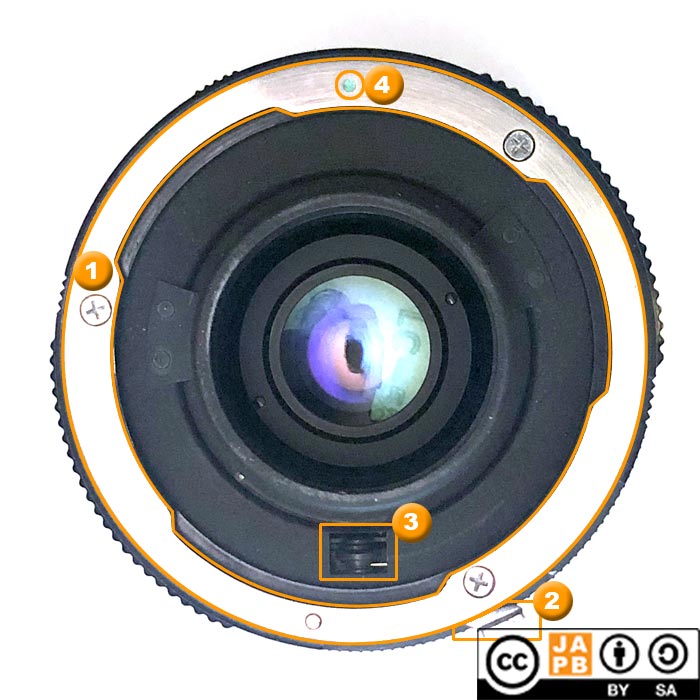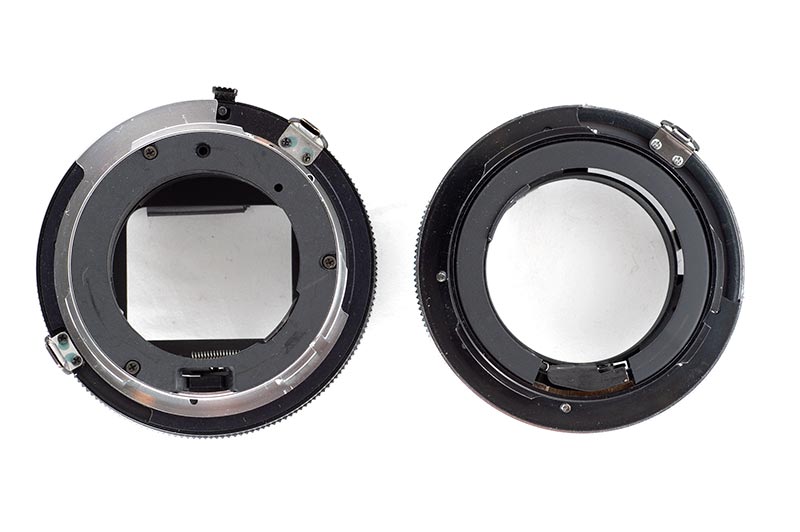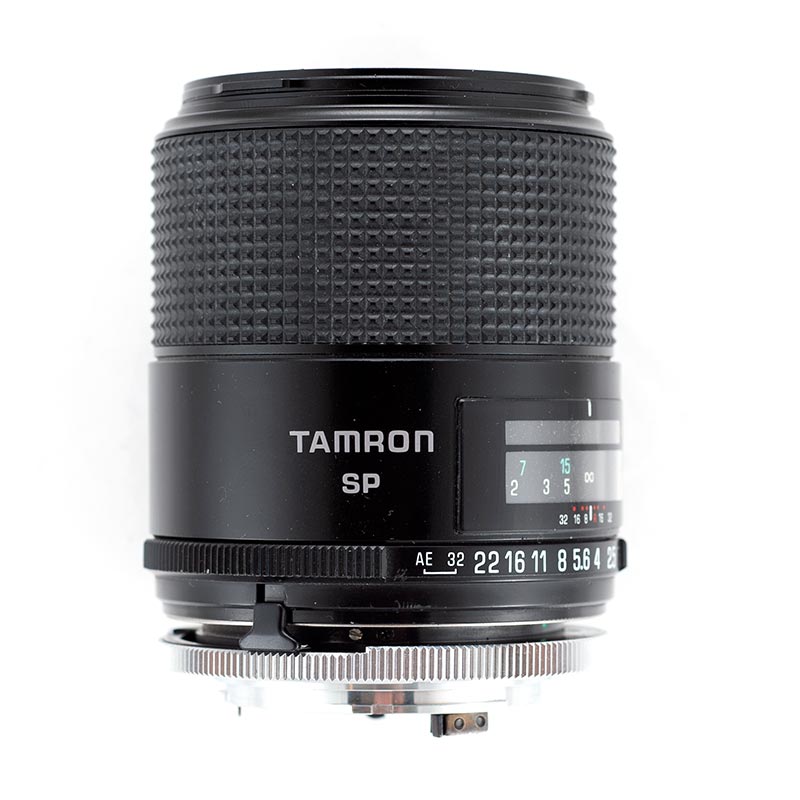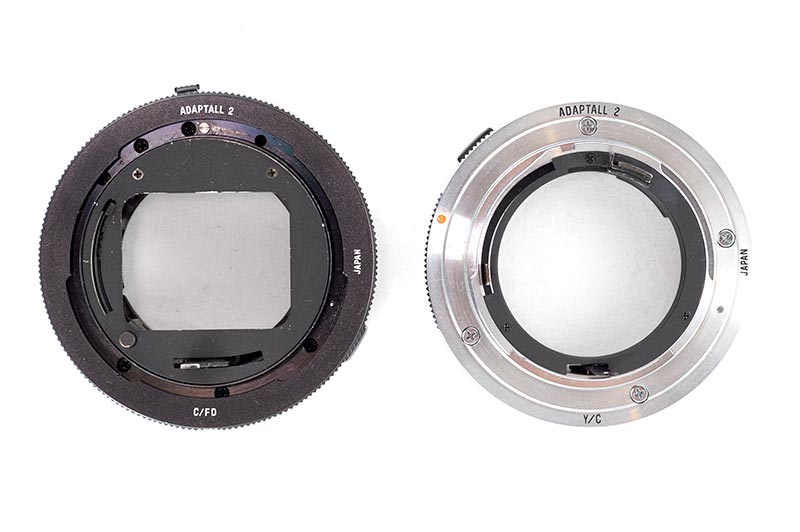Pekka Buttler (Updated 06/2025)
Introduction to the Tamron Adaptall mount:
The Tamron Adaptall is not – strictly speaking – a lens mount as there has never been a camera that uses the Adaptall mount, but is instead an intermediate mount. The purpose of such mounts is to allow third party lens manufacturers to easily make their lenses usable on a wide range of camera bodies, simply by attaching a suitable adapter to the lens.
Tamron Adaptall mount specifications and identification
Mount type: Bayonet mount, female type (adapter release on lens)
Flange focal distance: 50,70 mm
Sensor Size: 36,0 mm x 24,0 mm (Full frame)
Mount communication:
• Adaptall lenses are able to respond to aperture stop-down commands (mechanical) and able to communicate the selected aperture as well as AE lock (when relevant).
• Adaptall 2 lenses are further able to communicate a lens’ maximum aperture
• Which of these informations are then transmitted through the adapter ring to the camera depends on the host mount’s characteristics.

Key Characteristics of Tamron Adaptall lenses
[1] Female bayonet mount with three openings
[2] Adapter release lever
[3] Aperture stop-down mechanism (press to stop down lens)
[4] Adapter orientation indicator
History of Tamron and Tamron intermediate mounts.
Tamron, originally Taisei Optical Equipment Manufacturing, was founded in 1950 in the Japanese city of Urawa (nowadays Saitama), a bit north of Tokyo. Tamron originally manufactured cameras and binoculars, and while the binoculars sold well, the cameras did less so. In 1957 Tamron started manufacturing camera lenses with the intention of these lenses being used on a wide range of cameras. From the beginning Tamron’s approach was to use an intermediate mount to allow their lenses to be used on as wide as possible a range of cameras.
What is noteworthy is that Tamron is one of the few third party lens manufacturers to have remained in the business, while many (most) others have had to throw in the towel.
Tamron had a lot of success with its focus on producing lenses for intermediate mounts, but the increase of electronic lens-body communication and the advent of autofocus lenses forced Tamron to start producing their lenses separately for each mount.
Tamron’s success led to other manufacturers introducing their own intermediate mounts (see more on the JAPB article on intermediate mounts)

Tamron has a long history of producing lenses for intermediate mounts as well as designing such mounts, summarised below:
• ‘mini’ T mount (M37x0,75 mm thread), introduced in 1957
• T mount (M42x0,75 mm thread), introduced in 1962
• Tamron Adapt-a-Matic (breech-lock mount), introduced 1969
• Tamron Adaptall (bayonet mount), introduced 1973
• Tamron Adaptall-2 (bayonet mount), introduced 1980
Generally each new generation of the mount was launched in order to incorporate a functionality that the previous mount did not allow for:
• The switch from the original M37 T mount to the wider M42 T mount was to allow larger rear lens elements (and exit pupils)
• The switch to Adapt-a-Matic was to allow auto aperture and transmission of selected aperture
• and so on.
Importantly, Adaptall and Adaptall-2 are cross-compatible. The key difference between Tamron Adaptall and Adaptall-2 was that Adaptall-2 was able to communicate the lens’ maximum aperture (to such cameras that could use that information.)

Adapting Tamron Adaptall lenses
If you intend to adapt your Tamron Adaptall lens to a dSLR…
There are original Tamron Adaptall adapters to both Pentax K and Nikon F (Ai) available. These adapters allow you to use the tamron Adaptall lens as if it was a native (manual focus) lens (including aperture and aperture priority exposure automation). There are also modern adapters available from several adapter manufacturers, but – in general – these adapters are dumb adapters and do not allow aperture control.
If your dSLR is a Canon EF or Sony/Minolta A and Four thirds camera, you can get an aftermarket dumb adapter, but will have to manually control aperture.
If you intend to adapt your Tamron Adaptall lens to a mirrorless camera
If you already have a number of adapters from the typical SLR mounts to your mirrorless camera (e.g. Canon FD / m42 / Nikon F / Olympus OM / Pentax K …) your best choice is to either:
- get an original Tamron adapter from Adaptall to whatever your most favoured SLR era lens mount is or
- get a modern Tamron adapter to mirrorless adapter from one of the contemporary adapter manufacturers (K&F Concept seems to offer dumb adapters for Adaptall to most mirrorless mounts)
Of these, the earlier option is likely to be cheaper and the later less finicky.
If you intend to adapt your Tamron Adaptall lens to a film SLR

Right: Adaptall-2 to Contax/Yashica adapter
Given the nature of the Tamron Adaptall mount, this is – with most cameras – relatively easy as Tamron did produce a wide range of adapters, including (at least) Canon FD*, Contax/Yashica*, Fujica X†, Konica AR*, m421, Mamiya Z°, Minolta SR*, Miranda°, Nikon F° (pre-Ai and Ai), Olympus OM*, Pentax K (vanilla° and A-version†), Praktica B†, Rollei QBM° and Topcon RE° (Exakta).
Notes:
* Available both as Adaptall 1 and 2 (with different features)
° Available only as Adaptall 1
† Available only as Adaptall 2
Footnotes
1 Note, please. There were both adaptall adapters to vanilla m42 mounts as well as some of the m42 variants (such as Fujica m42, Mamiya m42, Praktica electronic m42). For details, see the JAPB article on the m42 mount.